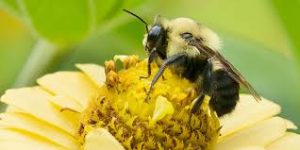03
Dec
Take Action: Protect Biodiversity – Reinstate the Ban of Bee-Toxic Neonicotinoid Pesticides on Wildlife Refuges
 (Beyond Pesticides, December 3, 2018) In August 2018, the Trump administration announced a reversal of a 2014 U.S. Fish and Wildlife (FWS) decision to ban neonicotinoid insecticides on National Wildlife Refuges. The administration’s action threatens not only pollinators, but contributes to the attack on biodiversity worldwide.
(Beyond Pesticides, December 3, 2018) In August 2018, the Trump administration announced a reversal of a 2014 U.S. Fish and Wildlife (FWS) decision to ban neonicotinoid insecticides on National Wildlife Refuges. The administration’s action threatens not only pollinators, but contributes to the attack on biodiversity worldwide.
In 2014, FWS announced that all National Wildlife Refuges would join in the phase-out of neonics (while also phasing out genetically engineered crops) by January 2016. FWS “determined that prophylactic use, such as a seed treatment, of the neonicotinoid pesticides that can distribute systemically in a plant and can potentially affect a broad spectrum of non-target species is not consistent with Service policy. We make this decision based on a precautionary approach to our wildlife management practices and not on agricultural practices.” This move was not only intended to protect honey bees that have suffered average losses above 30% since 2006, but also the federally threatened and endangered pollinators that live in National Wildlife Refuges.
However, it is not just pollinators who are affected. Recent research has found dramatic drops in overall insect abundance, leading entomologists to speak of an “insect apocalypse.” Various studies have found reductions of up to a factor 60 over the past 40 years –there were 60 times as many insects in some locations in the 1970s. Over 75% of insect abundance has declined over the last 27 years, according to new research published by European scientists in PLOS One. The dramatic drop in insect biomass has led to equally dramatic pronunciations from highly respected scientists and entomologists. “We appear to be making vast tracts of land inhospitable to most forms of life, and are currently on course for ecological Armageddon,” study coauthor David Goulson, Ph.D. of Sussex University, UK, told The Guardian. “If we lose the insects then everything is going to collapse.”
Insects play important roles in food webs –most song birds, for example, depend on insects during the breeding season, at least. Insects are important decomposers –Australia had to import dung beetles to handle the waste problem caused by the importation of cattle. They contribute to the health of soils. The loss of insect abundance poses cascading effects at all ecosystem levels.
Neonicotinoids also pose a direct threat to non-insect wildlife, including birds. Birds and other wildlife are mobile, moving in and out of crop fields without regard for pesticide treatments. Birds, in particular, absorb pesticide sprays and vapors through respiration, as well as orally in food and preening and dermally by walking in sprayed fields.
It is more important than ever to ban neonicotinoids in National Wildlife Refuges, which should be refuges from toxic chemical use.
Letter to Congress:
I am writing to ask you to urge the U.S. Fish and Wildlife Service and Department of Interior Secretary Ryan Zinke to reinstate the ban on neonicotinoid pesticides in wildlife refuges. In August 2018, the Trump administration announced a reversal of a 2014 U.S. Fish and Wildlife (FWS) decision to ban neonicotinoids on National Wildlife Refuges. The administration’s action threatens not only pollinators, but biodiversity of the whole planet.
In 2014, FWS announced that all National Wildlife Refuges would join in the phase-out of neonics (while also phasing out genetically engineered crops) by January 2016. FWS “determined that prophylactic use, such as a seed treatment, of the neonicotinoid pesticides that can distribute systemically in a plant and can potentially affect a broad spectrum of non-target species is not consistent with Service policy. We make this decision based on a precautionary approach to our wildlife management practices and not on agricultural practices.” This move was not only intended to protect honey bees that have suffered average losses above 30% since 2006, but also the federally threatened and endangered pollinators that live in National Wildlife Refuges. Over 75% of insect abundance has declined over the last 27 years, according to new research published by European scientists in PLOS One. The dramatic drop in insect biomass has led to equally dramatic pronunciations from highly respected scientists and entomologists. “We appear to be making vast tracts of land inhospitable to most forms of life, and are currently on course for ecological Armageddon,” study coauthor David Goulson, Ph.D. of Sussex University, UK, told The Guardian. “If we lose the insects then everything is going to collapse.”
However, it is not just pollinators who are affected. As recently summarized in a New York Times magazine article, “The Insect Apocalypse is Here,” recent research has found dramatic drops in overall insect abundance. Various studies have found reductions of up to a factor 60, over the past 40 years –there were 60 times as many insects in some locations in the 1970s. Insects play important roles in food webs –most song birds, for example, depend on insects during the breeding season, at least. Insects are also important decomposers –Australia had to import dung beetles to handle the waste problem caused by the importation of cattle. They contribute to the health of soils. The loss of insect abundance poses cascading effects at all ecosystem levels.
Neonicotinoids also pose a direct threat to non-insect wildlife, including birds. Birds and other wildlife are mobile, moving in and out of crop fields without regard for pesticide treatments. Birds are particularly vulnerable, having high metabolic and respiratory rates. They absorb pesticide sprays and vapors through respiration, as well as orally in food and preening and dermally by walking in sprayed fields.
It is more important than ever to ban neonicotinoids in National Wildlife Refuges, which should be refuges from toxic chemical use.
Sincerely,










